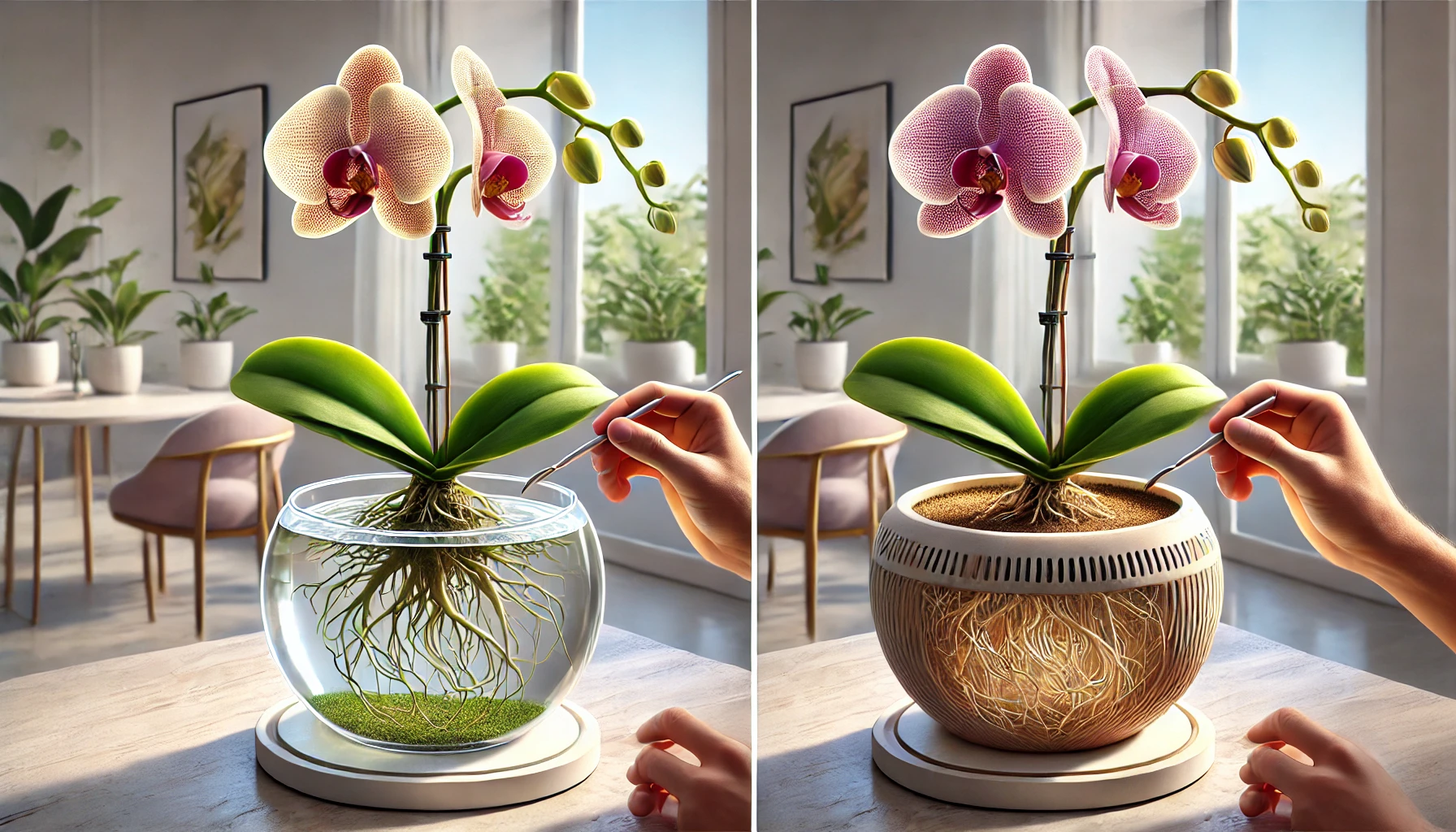Many orchid growers prefer using transparent pots, believing they improve root health and growth. But are they really necessary? While clear pots offer certain advantages, orchids can also grow well in other types of containers. Understanding the benefits, myths, and alternatives will help you decide the best pot for your orchid.
🌱 Why Are Orchids Often Sold in Transparent Pots?
Unlike most houseplants, orchids have aerial roots that naturally grow exposed to air and light. In the wild, many orchids attach to tree bark, absorbing moisture and nutrients from the air. Transparent pots mimic these conditions by allowing light to reach the roots, simulating their natural environment.
✔ Common Reasons for Using Clear Pots:
- Allow light penetration, helping roots photosynthesize.
- Make it easier to monitor root health (checking for rot or dryness).
- Help growers determine when to water based on root color.
- Provide better air circulation, reducing the risk of root suffocation.
💡 Transparent pots are especially useful for beginner growers who want to track their orchid’s health more easily.
🌞 Do Orchid Roots Really Need Light?
One of the biggest myths about orchids is that their roots require light for photosynthesis, just like leaves. While it’s true that some orchid roots can absorb light, the amount of energy they gain is minimal compared to the leaves.
✔ Truth About Orchid Root Photosynthesis:
- Orchid leaves are the primary site of photosynthesis, not the roots.
- Some orchids, like Phalaenopsis, have chlorophyll in their roots, but this is not essential for survival.
- Orchids grown in opaque pots can still thrive, as long as they receive proper light, water, and airflow.
💡 Light exposure to roots is beneficial but not mandatory—orchids can grow perfectly fine in non-transparent pots.
💧 Advantages of Transparent Pots for Orchid Care
While orchids don’t necessarily require clear pots, there are some practical advantages to using them.
✔ Easy Root Monitoring:
- Healthy roots appear green when moist and silvery-white when dry, helping determine watering needs.
- If roots turn brown or mushy, it’s a sign of root rot, making it easier to act quickly.
✔ Better Water Drainage Control:
- Growers can see if excess water is trapped in the pot, preventing overwatering.
- Checking for salt buildup or algae growth is easier in clear pots.
✔ Improved Growth for Certain Orchids:
- Some orchids, like Vanda, naturally grow with exposed roots, so a transparent pot provides a more familiar environment.
💡 If you often struggle with overwatering or root rot, a transparent pot can be a great tool to monitor your orchid’s health.
🏺 Can Orchids Grow in Opaque or Decorative Pots?
Absolutely! Many orchid varieties thrive in opaque, ceramic, or clay pots, as long as they have proper drainage and ventilation.
✔ Best Non-Transparent Pots for Orchids:
- Clay or Terracotta Pots: Absorb excess moisture, reducing the risk of overwatering.
- Ceramic Pots with Drainage Holes: Provide stability and a decorative look while allowing airflow.
- Wooden Baskets or Slotted Pots: Perfect for orchids like Vanda that need high air circulation.
✔ Situations Where Opaque Pots Work Well:
- If you live in a humid climate, opaque pots help prevent excess moisture buildup.
- If your orchid is mature and well-established, it doesn’t require as much root monitoring.
- If you prefer a decorative display, opaque pots can enhance home aesthetics.
💡 As long as the pot has proper drainage and ventilation, orchids can thrive in any container.
🚫 Common Myths About Transparent Pots
❌ “Orchids will die without a clear pot.”
- Truth: Orchids can grow in any pot that provides proper drainage and airflow.
❌ “Roots need constant light to stay healthy.”
- Truth: Light exposure can be helpful but is not essential for root health.
❌ “Transparent pots prevent root rot better than opaque pots.”
- Truth: Root rot is caused by overwatering and poor drainage, not the type of pot.
🌿 How to Choose the Best Pot for Your Orchid
If you’re unsure which type of pot to use, consider these factors:
✔ Use a Transparent Pot If:
- You want to monitor root health easily.
- You struggle with overwatering and need to see moisture levels.
- You are growing young or newly repotted orchids.
✔ Use an Opaque Pot If:
- You prefer a decorative pot that blends with your home.
- Your orchid is well-established and doesn’t need constant monitoring.
- You grow orchids in a humid climate where moisture retention isn’t an issue.
💡 Some growers use both—a transparent pot inside a decorative outer pot. This allows monitoring while keeping a stylish appearance!
📏 Best Pot Sizes and Drainage Features
Regardless of transparency, the size and drainage of the pot play a crucial role in orchid health.
✔ Ideal Pot Size:
- Choose a pot that is just slightly larger than the root system.
- Orchids prefer snug pots—excess space can lead to stagnant moisture.
✔ Drainage Requirements:
- Multiple drainage holes are essential to prevent root rot.
- Avoid pots with a solid bottom unless using an inner plastic pot with holes.
💡 Always prioritize drainage over appearance—an orchid in a well-draining pot is much healthier than one in a stylish but poorly ventilated pot.
🛡 Final Tips for Choosing the Right Orchid Pot
✔ Transparent pots are helpful but not mandatory for orchid health.
✔ Opaque pots work just as well if they have good drainage and ventilation.
✔ Consider using a clear pot inside a decorative pot for the best of both worlds.
✔ Monitor your orchid’s roots—green means hydrated, silvery-white means time to water.
✔ Choose the right size and shape to prevent overwatering or root crowding.
By understanding the truths and myths about transparent pots, you can confidently choose the best container for your orchid, ensuring it stays healthy, hydrated, and beautifully blooming! 🌸✨
